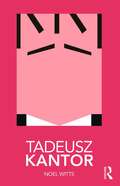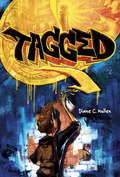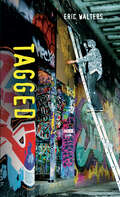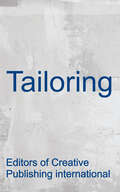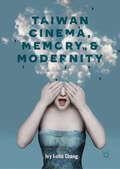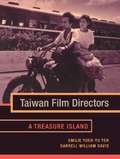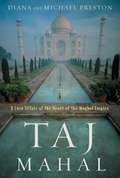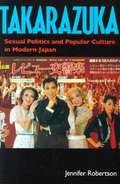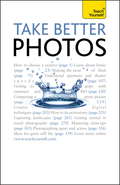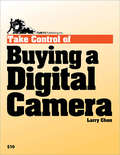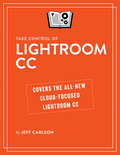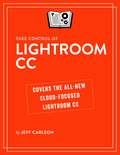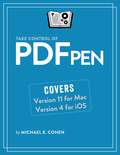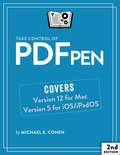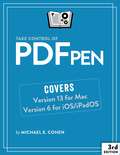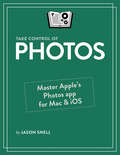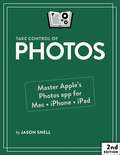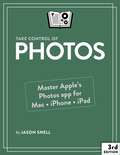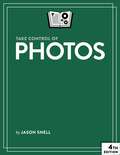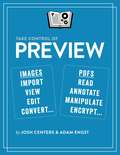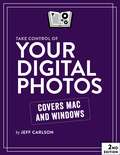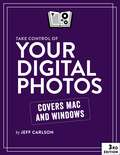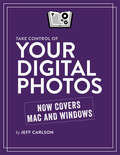- Table View
- List View
Tadeusz Kantor (Routledge Performance Practitioners)
by Noel WittsTadeusz Kantor – a theoretician, director, innovator and painter famed for his very visual theatre style – was a key figure in European avant-garde theatre. He was also known for his challenging theatrical innovations, such as extending stages and the combination of mannequins with living actors. The book combines: a detailed study of the historical context of Kantor’s work an exploration of Kantor’s own writings on his theatrical craft a stylistic analysis of the key works, including The Dead Class and Let the Artists Die, and their critical reception an examination of the practical exercises devised by Kantor. As a first step towards critical understanding, and as an initial exploration before going on to further, primary research, Routledge Performance Practitioners offer unbeatable value for today’s student.
Tagged
by Diane C. MullenLiam is a fourteen-year-old graffiti artist living in project housing in Minneapolis with his single mother and two younger siblings. When Liam's estranged older brother coerces him to tag a graffiti symbol for a rival gang, Liam's life is threatened. Due to his apathetic attitude in the classroom and on the baseball field, Liam's private-school scholarship is also threatened. His mother decides to send him to Lake Michigan for the summer to live with her best friend, Kat, a sculptor and art teacher, Liam soon delves into the work of Jean-Michel Basquiat, Pablo Picasso, and his own personal aesthetics. He's encouraged to consider his art seriously and how it might contribute to a greater community. Having to decide between staying with Kat and returning home to his siblings who need him, Liam's story inspires him to reinvent himself for the better.
Tagged (Orca Soundings)
by Eric WaltersThe city is cracking down on graffiti and guerilla art. Between that and cutbacks to the local art gallery it seems like nothing is safe. But Oswald, masquerading as a graffiti artist known as The Wiz, is fighting back--by painting elaborate murals in public places and planting art in the galleries, and then by taking on the mayor himself. As the fight escalates and the stakes become higher, Oswald gets in deeper than he meant to and needs to rely on his friends to get him out of his latest mess.
Tailoring: The Classic Guide to Sewing the Perfect Jacket
by Editors of Creative Publishing internationalWritten by sewing professionals, this book teaches the trusted, proven methods for sewing tailored jackets with impeccable details and perfect fit. Written for the intermediate sewer who wants to move on to more challenging projects, this book ensures success with detailed, step-by-step instructions, more than 400 photos, in-depth discussions about products and how to use them.
Tails from the Exotic Feline Rescue Center, 25th Anniversary Edition
by Bill Nimmo Joe Taft Stephen D. MccloudMeet Sahib, Sampson, Zulu, Rouge, Blaze--just a few of the 200 big cats that await visitors at the Exotic Feline Rescue Center. The EFRC, in Center Point, Indiana, is a nationally recognized leader in big cat rescue, conservation, and care. Almost all of these cats--tigers, bobcats, lions, pumas, and servals--are survivors of abuse and neglect. In this follow-up to Saving the Big Cats and Real Stories of Big Cat Rescues, photographer Stephen D. McCloud showcases the newest residents of this lush 108-acre sanctuary, now celebrating its 25th anniversary. Readers will be fascinated by the stories of these incredible feline predators in this anniversary edition, which includes a foreword by Tigers of America founder Bill Nimmo.
Taiwan Cinema, Memory, and Modernity
by Ivy I-chu ChangThis book investigates the aesthetics and politics of Post/Taiwan-New-Cinema by examining fifteen movies by six directors and frequent award winners in international film festivals. The book considers the works of such prominent directors as Edward Yang, Tsai Ming-liang and Chang Tsuo-chi and their influence on Asian films, as well as emergent phenomenal directors such as Wei Te-sheng, Zero Chou, and Chung Mong-hong. It also explores the possibility of transnational and trans-local social sphere in the interstices of layered colonial legacies, nation-state domination, and global capitalism. Considering Taiwan cinema in the wake of globalization, it analyses how these films represent the socio-political transition among multiple colonial legacies, global capitalism, and the changing cross-strait relation between Taiwan and the Mainland China. The book discusses how these films represent nomadic urban middle class, displaced transnational migrant workers, roaming children and young gangsters, and explores how the continuity/disjuncture of globalization has not only carved into historical and personal memories and individual bodies, but also influenced the transnational production modes and marketing strategies of cinema.
Taiwan Film Directors: A Treasure Island (Film and Culture Series)
by Emilie Yueh-yu Yeh Darrell William DavisFocusing on the work of four contemporary filmmakers—Ang Lee, Edward Yang, Hou Hsiao-hsien, and Tsai Ming-liang—the authors explore how these filmmakers broke from tradition, creating a cinema that is both personal and insistent on examining Taiwan's complex history. Featuring stills, anecdotes, and close readings of films, the authors consider the influence of Hong Kong and martial arts films, directors' experiments with autobiography, the shifting fortunes of the Taiwanese film industry, and Taiwan cinema in the context of international cinema's aesthetics and business practices.
Taj Mahal: Passion And Genius At The Heart Of The Moghul Empire
by Diana Preston Michael PrestonWhile Galileo suffered under house arrest at the hands of Pope Urban VIII, the Thirty Years War ruined Europe, and the Pilgrims struggled to survive in the New World, work began on what would become one of the Seven Wonders of the World: the Taj Mahal. Built by the Moghul emperor Shah Jahan as a memorial to his beloved wife, Mumtaz Mahal, its flawless symmetry and gleaming presence have for centuries dazzled everyone who has seen it, and the story of its creation is a fascinating blend of cultural and architectural heritage. Yet, as Diana & Michael Preston vividly convey in the first narrative history of the Taj, it also reflects the magnificent history of the Moghul Empire itself, for it turned out to mark the high point of the Empire's glory at the same time as it became a tipping point in Moghul fortunes.
Takarazuka: Sexual Politics and Popular Culture in Modern Japan
by Jennifer E. RobertsonFounded in 1913 as a counterpart to the all-male Kabuki theater, the all-female Takarazuka Revue is world-famous today for its rococo musical productions and fanatically devoted fans. Anthropologist Jennifer Robertson draws from over a decade of research to explore how the Revue illuminates popular culture in 20th-century Japan. 29 photos.
Take Better Photos: Teach Yourself
by Lee FrostTake Better Photos: Teach Yourself is your complete guide to all the practical know-how, technical information and creative insight that will turn you into a confident user of your camera. Covering the very latest in equipment, with essential and straightforward guides to all the techniques - from exposure to use of flash - it will also teach you how to use digital manipulation, software and all the other technology that will make your pictures strong and memorable. It explains how to do everything from choosing the camera that's right for you to composing your shots, along with helpful screengrabs showing you how to get the desired result on screen and paper alike. NOT GOT MUCH TIME? One, five and ten-minute introductions to key principles to get you started. AUTHOR INSIGHTS Lots of instant help with common problems and quick tips for success, based on the authors' many years of experience. TEST YOURSELF Tests in the book and online to keep track of your progress. EXTEND YOUR KNOWLEDGE Extra online articles at www.teachyourself.com to give you a richer understanding of photography. THINGS TO REMEMBER Quick refreshers to help you remember the key facts.
Take Control of Buying a Digital Camera
by Laurence ChenFind practical, real-world advice that helps you choose a digital camera!This book helps you cut through the marketing hype and confusing jargon to find the digital camera that's right for you. You'll learn which camera features are important, which ones aren't, and why. Rather than bury you with arcane technical details or a myriad of camera models, Larry first helps you determine how much you want to spend, what sort of pictures you're likely to take, and what aspects of using a camera are important to you. With that grounding, you're ready to learn about the different camera features, separated by those that are actually important and those that merely fill up feature checklists. The ebook even contains a camera comparison worksheet you can fill in while shopping. Additional sections give you pointers on how to read camera reviews (plus a list of the best review sites!), advice about evaluating picture quality, suggestions of where to buy your camera, the lowdown on accessories you might want, and tips on working with photos on your computer. Includes a coupon worth $5 off any order at Small Dog Electronics, chopping the price of this ebook in half if you buy your camera from Small Dog!
Take Control of Lightroom CC
by Jeff CarlsonImport, manage and edit your photos expertly with Lightroom CC!As more and more of us access and edit photos on many different devices--laptops, desktops, tablets, and phones--we increasingly expect a seamless experience, with our images and edits showing up on all our devices, immediately. To accommodate this shift, Adobe has released a new version of its Lightroom application, Lightroom CC, that is specifically designed for cloud interaction. Lightroom CC is streamlined and simplified, meant to appeal to those who want to do more than the basics with their photos, but who are intimidated by Lightroom Classic CC and Photoshop.In Take Control of Lightroom CC, photography expert Jeff Carlson gives a thorough, but accessible, guide to the new Lightroom CC. He explains where it fits in the Lightroom ecosystem, then moves on to detail how to import, manage, and professionally edit your photos using Lightroom CC. For those who want to keep using Lightroom Classic CC, he also looks at how the two programs can work together.With this book, you'll:Get the big picture: See how Lightroom CC and Lightroom Classic (as well as Lightroom Mobile and Lightroom for Web) work together Build your photo library: Learn how to import photos from cameras, memory cards, and locations on your hard disk; automatically add mobile photos; and sync photos, taking advantage of Lightroom CC's cloud-focused features. Organize your photos: Organize your photo library with rating and tagging, find photos using Adobe Sensei, manage your storage options, and back up your library.Edit your photos: Get a handle on essential editing basics (like working in the Edit panel); use crop, straighten, rotate and flip to re-orient photos; adjust lighting, color, and appearance; and apply presets.Share your photos: Post images directly to your friends online in Facebook, export them to disk in order to share them elsewhere, or make an entire album public for people to view and, optionally, to download.Work with Lightroom Classic CC: Learn how to migrate a Classic catalog, or discover how to run both programs together.
Take Control of Lightroom CC
by Jeff CarlsonThis book gives you all the information you need to use Lightroom CC, Adobe’s all-new desktop photo editor and organizer, from understanding where it fits in the Lightroom ecosystem (alongside Lightroom Classic, the rebranded and updated version of the traditional Lightroom application), to importing, managing, and professionally editing your photos.
Take Control of PDFpen
by Michael E. CohenPolish your PDFs with Smile's PDFpen, for a fraction of what Adobe Acrobat costs! Michael E. Cohen explains how you can create, combine, edit, annotate, and protect PDFs. Also learn how to perform and edit OCR, fill out forms, sign forms digitally, make interactive forms, and much more. Covers Mac and iOS versions!
Take Control of PDFpen
by Michael E. CohenPolish your PDFs with Smile's PDFpen, for a fraction of what Adobe Acrobat costs! Michael E. Cohen explains how you can create, combine, edit, annotate, and protect PDFs. Also learn how to perform and edit OCR, fill out forms, sign forms digitally, make interactive forms, and much more. Covers Mac and iOS versions!
Take Control of PDFpen
by Michael E. CohenPolish your PDFs with Smile's PDFpen, for a fraction of what Adobe Acrobat costs! Michael E. Cohen explains how you can create, combine, edit, annotate, and protect PDFs. Also learn how to perform and edit OCR, fill out forms, sign forms digitally, make interactive forms, and much more. Covers Mac and iOS/iPadOS versions!
Take Control of Photos
by Jason SnellTake control of your photo collection in Photos for Mojave and iOS 12!Get to know Apple's Photos app and how best to use it to import, manage, edit, and share your photos in Mojave and iOS 12! As the successor to Apple's iPhoto and Aperture apps, Photos has a more refined interface and deeper connections to iCloud, and it runs faster. Following the expert advice of Jason Snell, publisher of Six Colors and former lead editor at Macworld, you'll learn how to navigate Photos like a pro!This 156-page book replaces and more than doubles the length of Jason's previous book Photos: A Take Control Crash Course. It's now a full-length Take Control title with much more detail.In this book, you'll learn how to:Migrate your library from iPhoto or Aperture (Apple's discontinued professional photography app) into PhotosImport photos from devices or memory cardsUse multiple Photos librariesNavigate the Photos interface, including the sidebar and iconsView, edit, or disable Live PhotosOrganize your library by using enhanced search features, adding metadata, building albums, and creating smart albumsEdit your photos using quick fixes like cropping, applying filters, and fixing red-eye and rotation problemsUse advanced editing techniques within Photos and edit using external apps like PhotoshopManage your photo collection using the Memories and People features, and get summary viewsSync and share your photos with iCloudView your photos on an Apple TVShare your photos via social media, export them out of Photos, or turn them into slideshowsCreate printed objects (such as books and calendars) from your photos using third-party servicesJason also highlights changes in Photos under iOS 12, including searching for multiple items at once, a For You tab, and an updated Import tab; plus changes in Mojave, including new keyboard shortcuts and the removal of built-in features for making calendars, books, and other printed materials (and alternative means of obtaining them).This book, which is about the new versions of Photos that Apple released in September 2018, covers Photos for macOS version 4.0 in Mojave, as well as Photos in iOS 12 and tvOS 12.
Take Control of Photos
by Jason SnellThis book introduces you to the many features of Apple’s Photos app on Mac, iPad, and iPhone, with advice on navigating the interface, editing your images, searching your library like a pro, syncing with iCloud Photos, sharing photos with others, and creating photo books.
Take Control of Photos
by Jason SnellThis book introduces you to the many features of Apple’s Photos app on Mac, iPad, and iPhone, with advice on navigating the interface, editing your images, searching your library like a pro, syncing with iCloud Photos, sharing photos with others, and creating photo books.
Take Control of Photos
by Jason SnellThis book introduces you to the many features of Apple’s Photos app on Mac, iPad, and iPhone, with advice on navigating the interface, editing your images, searching your library like a pro, syncing with iCloud Photos, sharing photos with others, and creating photo books.
Take Control of Preview
by Adam Engst Josh CentersApple's Preview app is bundled with every Mac and yet many Mac users have only a shallow understanding of what it's capable of. Mac experts Adam Engst and Josh Centers have plumbed Preview's depths to create a cheerful, colorful book that explains dozens of techniques for importing, viewing, editing, and converting images in Preview. It also puts you in control of reading, annotating, manipulating, and encrypting PDFs.
Take Control of Preview
by Adam Engst Josh CentersApple's Preview app is bundled with every Mac and yet many Mac users have only a shallow understanding of what it's capable of. Mac experts Adam Engst and Josh Centers have plumbed Preview's depths to create a cheerful, colorful book that explains dozens of techniques for importing, viewing, editing, and converting images in Preview. It also puts you in control of reading, annotating, manipulating, and encrypting PDFs.
Take Control of Your Digital Photos
by Jeff CarlsonThis book gives photographers using Mac or Windows computers the information they need to build and maintain a digital photo workflow that makes it easy to import, rate, tag, and store photos to find them quickly and easily later. It helps you spend more time on the enjoyable aspects of photography—shooting and viewing your photos—and less on the mundane but essential task of managing all your photos.
Take Control of Your Digital Photos
by Jeff CarlsonThis book gives you the information you need to build and maintain a digital photo workflow that makes it easy to import, rate, tag, and store photos to find them quickly and easily later. It helps you spend more time on the enjoyable aspects of photography—capturing and viewing your photos—and less on the mundane but essential task of managing all your photos.
Take Control of Your Digital Photos (1.0)
by Jeff CarlsonThis book gives photographers using Mac or Windows computers the information they need to build and maintain a digital photo workflow that makes it easy to import, tag, rate, and store photos to find them quickly and easily later. It primarily covers macOS 10.12 Sierra or later, Windows 10, and iOS 10 or later. It helps you spend more time on the enjoyable aspects of photography—shooting and viewing your photos—and less on the mundane but essential task of managing all your photos.
